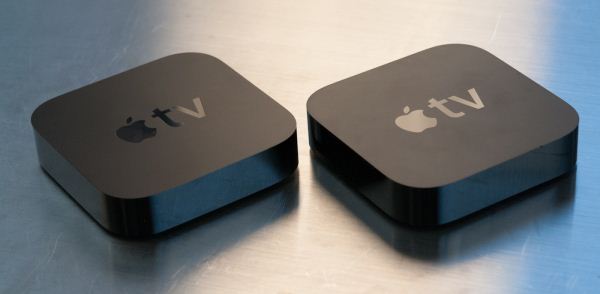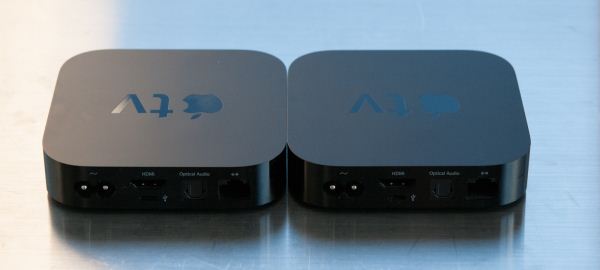Apple TV 3 (2012) Short Review - 1080p and better WiFi
by Brian Klug on March 21, 2012 4:21 PM ESTThe iPad (3) took front row during the recent launch extravaganza, however Apple also refreshed their Apple TV with a new model sporting a single core A5 SoC and some other noteworthy tweaks. We've spent some time with the new model since its launch, and have found a few interesting new things lurking inside. In addition to decoding 1080p iTunes content as well as YouTube and Netflix streams, the new Apple TV also includes a second WiFi antenna with better gain, which translates to improved reception and network throughput.
Quick, from the photo above, can you tell which Apple TV is the third generation device? Externally, the Apple TV 3rd generation is virtually indistinguishable from the Apple TV 2nd generation. The new device keeps the exact same dimensions and mass, in fact, during my testing the only way to tell the two apart was to compare the model number at the bottom. This is pretty unsurprising for an Apple product cycle, where you see successive generations inherit the same external design even as internals evolve or change dramatically. On the box, the new Apple TV 3 now includes both a 1080p marking and an Energy Star logo, something the previous model didn't.
Ports on the backside are unsurprisingly identical as well, as are the material choices. I've managed to leave quite a few scratches in the back of my Apple TV 2 over time, and the same glossy (if somewhat scratch-prone) plastic rings the device. No doubt that plastic choice was made originally both for RF propagation characteristics (low density, probably low carbon) and also so that IR works in the front. The real change again is that the Apple TV 3 now supports 1080p50 and 1080p60 over HDMI, where the previous Apple TV 2 only supported 720p50 and 720p60 at maximum over HDMI. Ethernet is still 10/100, there's still a microUSB port for restoring and flashing, and full size optical TOSLINK.
At the risk of sounding redundant, the accessories and remote inside are the same as the Apple TV 2 as well, namely an aluminum IR remote and the same length power cable. I don't think Apple's neat little aluminum remote needed any changing, nor did the power cable, but it's worth noting. The obvious upside is that if you're upgrading, everything about the current setup (power cable, HDMI, and space required) has stayed the same. If you're as obsessive about having a neatly wired home theater cabinet or stand as I am, this is definitely an upside.


















37 Comments
View All Comments
Teeeee - Wednesday, March 21, 2012 - link
You didn't mention that when Mountain lion is used with AirPlay, that anything you could play on your Mac could be displayed via the apple tv, including previous downloaded shows and stuff in additional file formats or websites.Brian Klug - Thursday, March 22, 2012 - link
I've updated with a clearer mention. Admittedly I haven't gotten around to trying Mountain Lion out, however.-Brian
relentlessfocus - Wednesday, March 21, 2012 - link
I personally feel that Apple's strategy is to make the iPad and possibly the iPhone the real source for content with the AppleTV being only an iOS tv accessory. With 100 million iPads sometime in 2012 and a few hundred million iPhones its a nice accessory to have.Hulu I believe is on the iPad in the US, certainly here in the UK its possible to mirror the BBC's iPlayer to the AppleTV even though there isn't an AppleTV iPlayer app (yet). Bloomberg TV Airplays nicely to the AppleTV and Sky and other channels here in the UK are on the iPad. Given the complexity of digital rights its far easier for Apple to let the copyright owners make their own apps for the iPad than it is to work out deals with Apple as middleman via iTunes.
Fanfoot - Tuesday, March 27, 2012 - link
Well, sort of.On iOS Apple has allowed app developers to block mirroring to the Apple TV. For example, HBO Go and Hulu both do NOT allow mirroring on the iPad. So for the moment, an Apple TV isn't as good a TV streamer device as some others if you judge it simply on its abilities to play back HBO Go or Hulu Plus or whatever.
With Mountain Lion Apple seems to be taking a different stance, simply encoding whatever is on the display and since most viewing is done inside a browser, it isn't clear how/if any site will be able to block mirroring from working. Right now the working assumption is that sites like the free Hulu WILL work on Mountain Lion. Which may help to push things forward and stop this sort of behavior on iOS devices going forward.
ltcommanderdata - Wednesday, March 21, 2012 - link
"While most of the attention this previous week has been focused on Apple's A5X SoC inside the iPad (3rd Gen), the other Apple-SoC news is that of the S5L8942 or A5 revision 2 inside the Apple TV 3, and iPad2,4."In page 2 of the article you mention the iPad2,4? Where does this come from? Are you saying Apple quietly revved the iPad 2 when they dropped the price to $399? Hopefully not. With 1x512MB on a 1x32-bit memory bus in the new A5 versus 2x256MB on a 2x32-bit memory bus in the old A5, that would fragment the iPad 2 userbase with different performance profiles.
Brian Klug - Thursday, March 22, 2012 - link
The iPad2,4 reference comes from numerous configuration files/plist files in iOS 5.1. At this point I don't know if it's simply the iPad 2 R2 (aka cheapified iPad 2) or something else, and I think the jury is still out. Even so it's possible to just put a different memory device on top and maintain 2x32 (which I hope they've done) whereas the ATV3 just gets the 1x32 512 MB device.Again, I haven't seen that iPad out in the wild, but it definitely includes the same Apple SoC revision.
-Brian
ltcommanderdata - Thursday, March 22, 2012 - link
Maybe it's the much speculated iPad Mini? Personally, given Apple's talk of iPads in education and the learning potential that is there for students, I'm hoping it's a cut down education specific iPad 2 model. A single core A5 should be sufficient for iBook textbooks and learning games and selling it with dramatically reduced profit margin at say a $249 unit price would really drive school adoption. It won't be an immediate money maker for Apple, but early iOS familiarity can ripple into continued iOS customers as the kids grow up. All pure speculation of course.Morelian - Wednesday, March 21, 2012 - link
I've owned the Apple TV (2) for the past year or so and have found it a useful device. We have multiple Iphones and Ipads in the house so the airplay thingy is good, and the apple tv will get media off the windows pcs as well. In my house it is mostly used as the Netflix access device hooked up to the 52 inch hdtv. The Netflix app on the Apple TV is better than the one on the Sony Blueray player.The selling point to me is if you have other Apple products the device is handy but even if you don't, it still is a good buy if your TV doesn't have a Netflix player attached.
This review tells me I should get new Apple TV for the big TV and give the kids who have the little TV the old one :P
amagrude - Wednesday, March 21, 2012 - link
The remote is slightly different in the Apple TV v3. The top 4-way circle has a pronounced circle bulge along the inner circle. The v2 remote (and every other metal one I've used) was rounded smooth in the shape of the contour of the remote. I like the new feel better - easier to get your finger into the center of that 4-way switch w/o looking.Brian Klug - Thursday, March 22, 2012 - link
Weird, I bought my Apple TV 2 about halfway into its product cycle, so I think I might've just gotten the updated remote.Compare if you will the Apple TV 2 and 3 remote (the 2 is the one with small dents/scuffs from where I've dropped it) in the gallery: http://www.anandtech.com/Gallery/Album/1822#13
http://www.anandtech.com/Gallery/Album/1822#12
-Brian